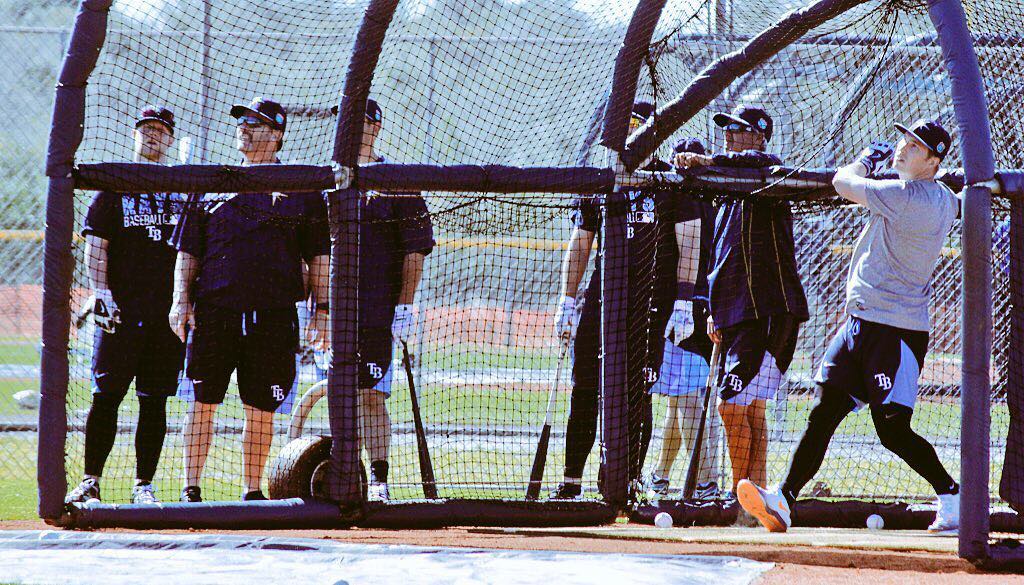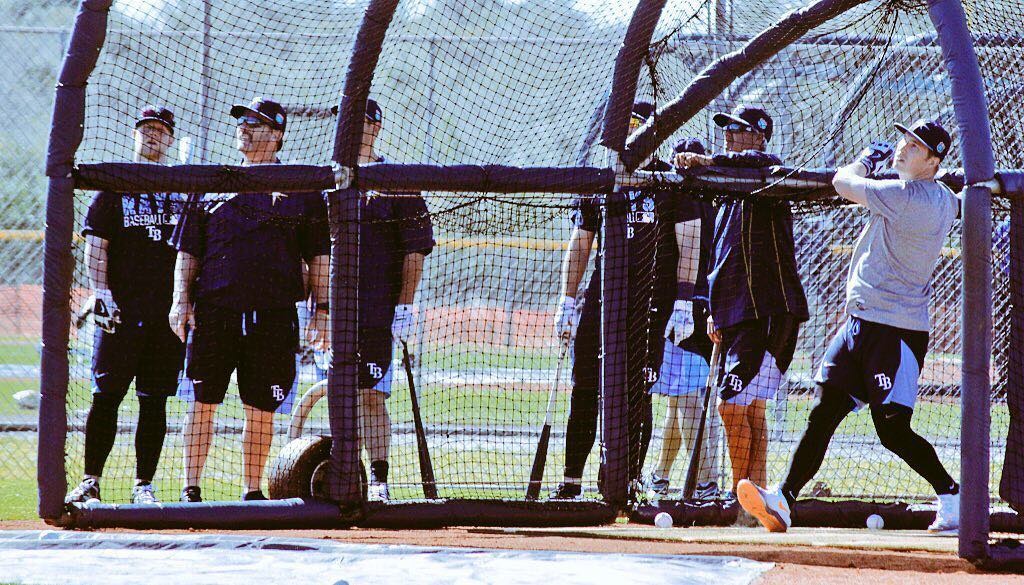
Friday marked the first full-squad workout for the Tampa Bay Rays, and they’ll open the Grapefruit League season against the Nationals on Wednesday. With the entire team now fully immersed in Spring Training, we decided to take a look at some of the other 2016 projections.
Eephus League depth projection
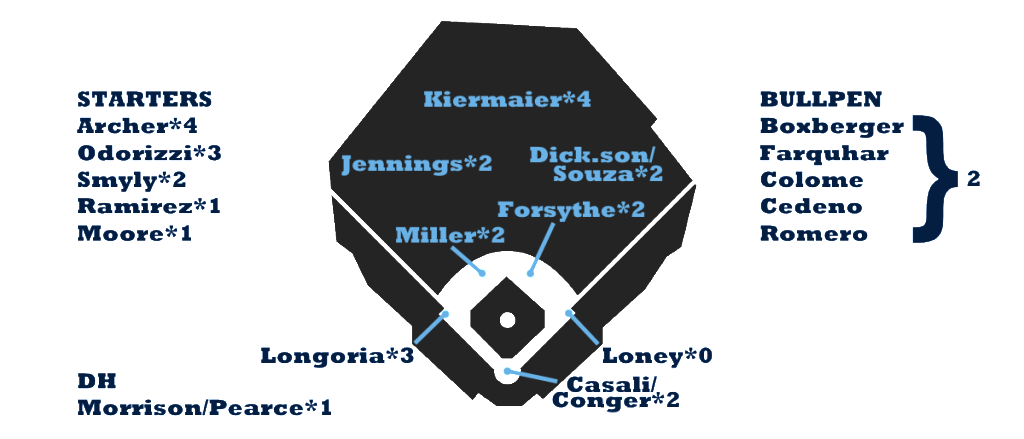
For starters, located above is a rough depth chart for the Rays, with rounded projected 2016 WAR totals for each player. The chart was constructed by considering the WAR totals listed on FanGraphs, along with the author’s own reasoning…whatever that may be.
Desmond Jennings, Kevin Kiermaier, Corey Dickerson and Steven Souza Jr. are projected to see the bulk of the playing time in the outfield, rounded out by Brandon Guyer who is the presumed bench depth. The infield looks to be composed Evan Longoria, Brad Miller, Logan Forsythe, and James Loney.
What I find interesting, both Jennings and Loney have been the fodder of trade speculation since the end of the 2015 season, yet there they are ― projected to take an active role in the Rays’ 2016 squad.
More curious, Logan Morrison and Steve Pearce project to platoon the DH spot, and nothing else. I think the more likely scenario would be Morrison platooning first with Loney, Pearce sharing a platoon role in the outfield, and Morrison and Pearce sharing DH duties.
Unfortunately for Richie Shaffer, it seems probable that he will start the season in Triple-A, likely not returning to the bigs until Loney is dealt, or a roster spot is opened due to an injury.
Eephus League also sees Curt Casali and Hank Conger sharing the catching duties. True, Rene Rivera was rather abysmal in the batter’s box last season, yet the team awarded the maligned catcher with a raise by way of arbitration. Moreover, both Casali and Conger have options remaining, making it a bit odd that the former wouldn’t at least start the year in Durham.
ZiPS
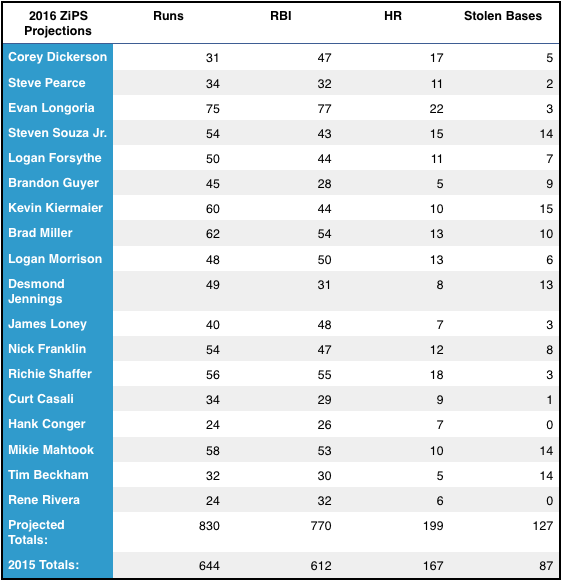
The runs/RBI/HR/stolen bases chart above is fairly straight forward. ZiPS projects the team to plate 117 more runs than PECOTA (at 713). The 830 runs and 770 RBI would be a vast improvement over last season, when Tampa Bay scored just 644 times on the backs of 612 RBI. It bears mentioning, however, the Rays won’t have 18 position players this on the 25-man roster this season, so the projected numbers are a bit skewed.
In some cases, the projected offensive totals appear to be rather conservative as compared to last season. Allow me to explain.
Take for example Evan Longoria, who crossed the plate 74 times and drove in 73 in 2015. Longo also led the team with 21 homers, while swiping three bags. It, by all accounts, was a down year for the face of the franchise. Looking toward this season, ZiPS projects that he will barely improve, a trend that also holds true for Souza, Guyer, Kiermaier, and Tim Beckham.
Other players are projected to make a larger impact on the team this season over last ― Jennings, Loney, Nick Franklin, Casali, Rivera, Shaffer and Mikie Mahtook. The impact of the newest acquisitions ― Pearce, Miller, Morrison, and Dickerson ― should also be taken into consideration. Whether Franklin, Casali, Shaffer, and Mahtook crack the Opening Day roster fails to be seen at the moment.
In short, ZiPS projects a more offensively dynamic team that puts the ball in play and drives in runs as a team, and swipes bags at a far greater clip than the season previous. To put things into perspective, each player is projected to average 46 runs and 43 RBI, up from 36 and 34 (respectively).
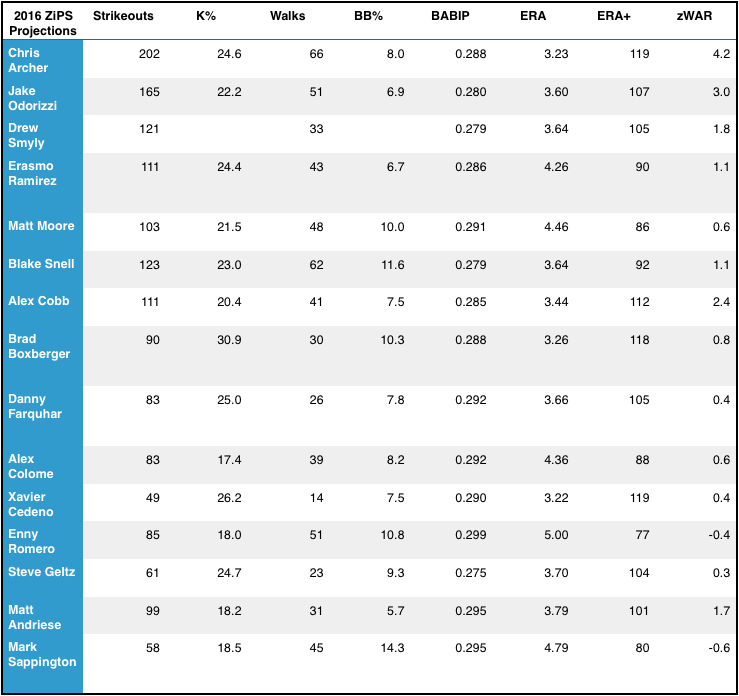
As for pitching ― and as it relates to WAR ― ZiPS projects regressions from Archer (5.3 WAR last season) and Ramirez (2.4 WAR last season), and improvements from Odorizzi and the left-handed tandem of Smyly and Moore ― both of whom spent a significant amount of time on the DL in 2015.
Rather surprisingly, Alex Cobb looks to bounce back from his stint on the DL following Tommy John surgery in May of last year. Cobb is projected to post a rather healthy 2.4 WAR in 111 innings of work. Do I think it’s reasonable for Cobb to amass the numbers above? No.
A quick bounce back from Tommy John surgery is something that rarely happens…just ask Matt Moore. Furthermore, to assume that Cobb would eat up that many innings, when he isn’t expected back until the beginning of August, just doesn’t seem plausible.
Why projections?
You may now be wondering why or how we use projections?
According to Dan Szymborski (ESPN Insider, creator of ZiPS), projections are a way to filter through the glut of player data that’s readily available at your finger tips:
Projections help cut down on an overwhelming amount of player data now readily available, Szymborski said. While there are always things computer projections won’t do well, one thing computers do manage well is a dispassionate, ‘just-the-facts’ guess.
In short, projections give you an initial impression of a player’s upcoming-season value, without that player’s driven opinion of himself. From there, it’s your choice to agree with the projection as the player’s most probable season outcome.
Unfortunately projections provide you with a black-and-white answer to a question that may best be answered in gray. Projections do not account for random variance, the reason an individual player projection may wind up off the mark. If anything, projections are better used as a starting point rather than a conclusion. Any given projection system isn’t designed to perfectly predict the future, rather it is designed to give the best estimate about how good a player is.
Noteworthiness
In case you missed it a couple of other projection pieces have been published on X-Rays Spex. Here’s what may have alluded you:
― On February 12, we began dissecting the 2016 ZiPS projections.
― On February 17, PECOTA projected Tampa Bay to lead the AL East on the back of 91 wins.

